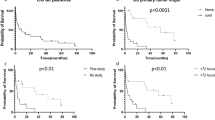Abstract
Purpose
Programmable ventriculoperitoneal shunts (pVP shunts) are increasingly utilized for intraventricular chemotherapy, radioimmunotherapy, and/or cellular therapy. Shunt adjustments allow optimization of drug concentrations in the thecal space with minimization in the peritoneum. This report assesses the success of the pVP shunt as an access device for intraventricular therapies. Quantifying intrathecal drug delivery using scintigraphy by pVP shunt model has not been previously reported.
Methods
We performed a single-institution, retrospective analysis on patients with CNS tumors and pVP shunts from 2003 to 2020, noting shunt model. pVP flow was evaluated for consideration of compartmental radioimmunotherapy (cRIT) using In-111-DTPA scintigraphy. Scintigraphy studies at 2–4 h and at 24 h quantified ventricular-thecal and peritoneal drug activity.
Results
Twenty-two CSF flow studies were administered to 15 patients (N = 15) with diagnoses including medulloblastoma, metastatic neuroblastoma, pineoblastoma, and choroid plexus carcinoma. Six different types of pVP models were noted. 100% of the studies demonstrated ventriculo-thecal drug activity. 27% (6 of 22) of the studies had no peritoneal uptake visible by imaging. 73% (16 of 22) of the studies had minimal relative peritoneal uptake (< 12%). 27% (6 of 22) of the studies demonstrated moderate relative peritoneal uptake (12–37%). No studies demonstrated peritoneal uptake above 37%.
Conclusions
All patients had successful drug delivery of In-111-DTPA to the ventriculo-thecal space. 73% of the patients had minimal relative (< 12%) peritoneal drug uptake. Though efficacy varies by shunt model, low numbers preclude conclusions regarding model superiority. CSF flow scintigraphy studies assesses drug distribution of In-111-DTPA, informing CSF flow for delivery of intraventricular therapies.



Similar content being viewed by others
Availability of data/material
De-identified patient data will be shared upon reasonable request. Data in addition to that provided in this report that would be considered for sharing upon request are imaging techniques, and pertinent radiographic images.
References
Belykh E, Shaffer KV, Lin C, Byvaltsev VA, Preul MC, Chen L (2020) Blood-brain barrier, blood-brain tumor barrier, and fluorescence-guided neurosurgical oncology: delivering optical labels to brain tumors. Front Oncol 10:739. https://doi.org/10.3389/fonc.2020.00739
Pardridge WM (2005) The blood-brain barrier: bottleneck in brain drug development. NeuroRx 2(1):3–14. https://doi.org/10.1602/neurorx.2.1.3
Burger MC, Wagner M, Franz K, Harter PN, Bahr O, Steinbach JP, Senft C (2018) Ventriculoperitoneal shunts equipped with on-off values for intraventricular therapies in patients with communicating hydrocephalus due to leptomeningeal metastases. J Clin Med 7(8):216. https://doi.org/10.3390/jcm7080216
Ferraris C, Cavalli R, Panciani PP, Battaglia L (2020) Overcoming the blood-brain barrier: successes and challenges in developing nanoparticle-mediated drug delivery systems for the treatment of brain tumours. Int J Nanomedicine 15:2999–3022. https://doi.org/10.2147/IJN.S231479
Hersh DS, Wadajkar AS, Roberts N, Perez JG, Connolly NP, Frenkel V, Winkles JA, Woodworth GF, Kim AJ (2016) Evolving drug delivery strategies to overcome the blood brain barrier. Curr Pharm Des 22(9):1177–1193. https://doi.org/10.2174/1381612822666151221150733
Gholamrezanezhad A, Shooli H, Jokar N, Nemati R, Assadi M (2019) Radioimmunotherapy (RIT) in brain tumors. Nucl Med Mol Imaging 53(6):374–381. https://doi.org/10.1007/s13139-019-00618-6
Zada G, Chen TC (2010) A novel method for administering intrathecal chemotherapy in patients with leptomeningeal metastases and shunted hydrocephalus: case report. Oper Neurosurg. https://doi.org/10.1227/01.NEU.0000383138.78632
Souweidane MM, Kramer K, Pandit-Taskar N, Zhou Z, Haque S, Zanzonico P, Carrasquillo JA, Lyashchenko SK, Thakur SB, Donzelli M, Turner RS, Lewis JS, Cheung NKV, Larson SM, Dunkel IJ (2018) Convection-enhanced delivery for diffuse intrinsic pontine glioma: a single-centre, dose-escalation, phase 1 trial. Lancet Oncol 19(8):1040–1050. https://doi.org/10.1016/S1470-2045(18)30322-X
Bailey K, Pandit-Taskar N, Humm JL, Zanzonico P, Gilheeney S, Cheung KV, Kramer K (2019) Targeted radioimmunotherapy for embryonal tumor with multilayered rosettes. J Neurooncol 143(1):101–106. https://doi.org/10.1007/s11060-019-03139-6
Patterson JD, Henson JC, Breese RO, Bielamowicz KJ, Rodriguez A (2020) CAR T cell therapy for pediatric brain tumors. Front Oncol 10:1682
Acknowledgements
The authors acknowledge support of the National Cancer Institute Cancer Center Support Grant P30 CA 008748. The authors thank Joseph Olechnowicz (editor, Memorial Sloan Kettering Cancer Center) for editorial assistance. We are grateful to our patients and families for allowing us to participate in their clinical care.
Author information
Authors and Affiliations
Contributions
All authors contributed to the analysis and interpretation of reviewed data, contributed to the writing of the manuscript, and reviewed and approved the final version.
Corresponding author
Ethics declarations
Competing interest
Kim Kramer discloses paid consulting for and holding equity in YmAbs Therapeutics, Inc. Kim Kramer also discloses expert testimony (Tydings) and patents pending. N. Pandit-Taskar has served as a consultant for or been on an advisory board and has received honoraria for Actinium Pharma, Progenics, Medimmune/Astrazeneca, Illumina, ImaginAb, and conducts research institutionally supported by Ymabs, ImaginAb, BMS, Bayer, Clarity pharma, Janssen and Regeneron. The remaining authors declare no competing financial interests.
Additional information
Publisher's Note
Springer Nature remains neutral with regard to jurisdictional claims in published maps and institutional affiliations.
Rights and permissions
About this article
Cite this article
McThenia, S.S., Pandit-Taskar, N., Grkovski, M. et al. Quantifying intraventricular drug delivery utilizing programmable ventriculoperitoneal shunts as the intraventricular access device. J Neurooncol 157, 457–463 (2022). https://doi.org/10.1007/s11060-022-03989-7
Received:
Accepted:
Published:
Issue Date:
DOI: https://doi.org/10.1007/s11060-022-03989-7




